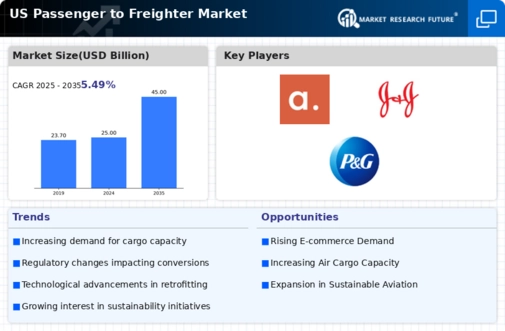The passenger to freighter market is currently characterized by a dynamic competitive landscape, driven by increasing demand for air cargo capacity and the need for efficient logistics solutions. Major players such as Boeing (US), Airbus (US), and Lockheed Martin (US) are strategically positioning themselves through innovation and partnerships. Boeing (US) has focused on enhancing its freighter conversion programs, while Airbus (US) is expanding its A320 family conversions to meet rising e-commerce demands. Lockheed Martin (US) is leveraging its defense expertise to explore dual-use aircraft conversions, indicating a trend towards versatile airframes that can serve both passenger and cargo needs.
Key business tactics within this market include localizing manufacturing and optimizing supply chains to enhance operational efficiency. The competitive structure appears moderately fragmented, with several key players exerting influence over market dynamics. This fragmentation allows for niche players to emerge, yet the collective strength of major companies shapes the overall competitive environment, fostering innovation and driving technological advancements.
In November 2025, Boeing (US) announced a partnership with a leading logistics firm to develop a new freighter conversion program aimed at increasing the efficiency of cargo operations. This strategic move is likely to enhance Boeing's market share by addressing the growing demand for sustainable and efficient air freight solutions. The collaboration is expected to leverage advanced technologies, potentially setting a new standard in the industry.
In October 2025, Airbus (US) unveiled its latest A321 freighter conversion, which incorporates cutting-edge digital technologies to optimize cargo loading and unloading processes. This initiative not only reflects Airbus's commitment to innovation but also positions the company to capture a larger segment of the growing e-commerce market. The integration of digital tools is anticipated to streamline operations, thereby enhancing customer satisfaction and operational efficiency.
In September 2025, Lockheed Martin (US) secured a contract to convert a fleet of passenger aircraft into freighters for a major logistics provider. This contract underscores Lockheed's strategic focus on dual-use aircraft, which may provide a competitive edge by catering to both military and commercial markets. The versatility of these conversions could lead to increased demand, particularly in a market that values flexibility and rapid response capabilities.
As of December 2025, current competitive trends indicate a strong emphasis on digitalization, sustainability, and AI integration within the passenger to freighter market. Strategic alliances are increasingly shaping the landscape, as companies recognize the need for collaboration to enhance technological capabilities. Moving forward, competitive differentiation is likely to evolve from traditional price-based competition to a focus on innovation, technology, and supply chain reliability, reflecting the industry's shift towards more sustainable and efficient operational practices.














Leave a Comment